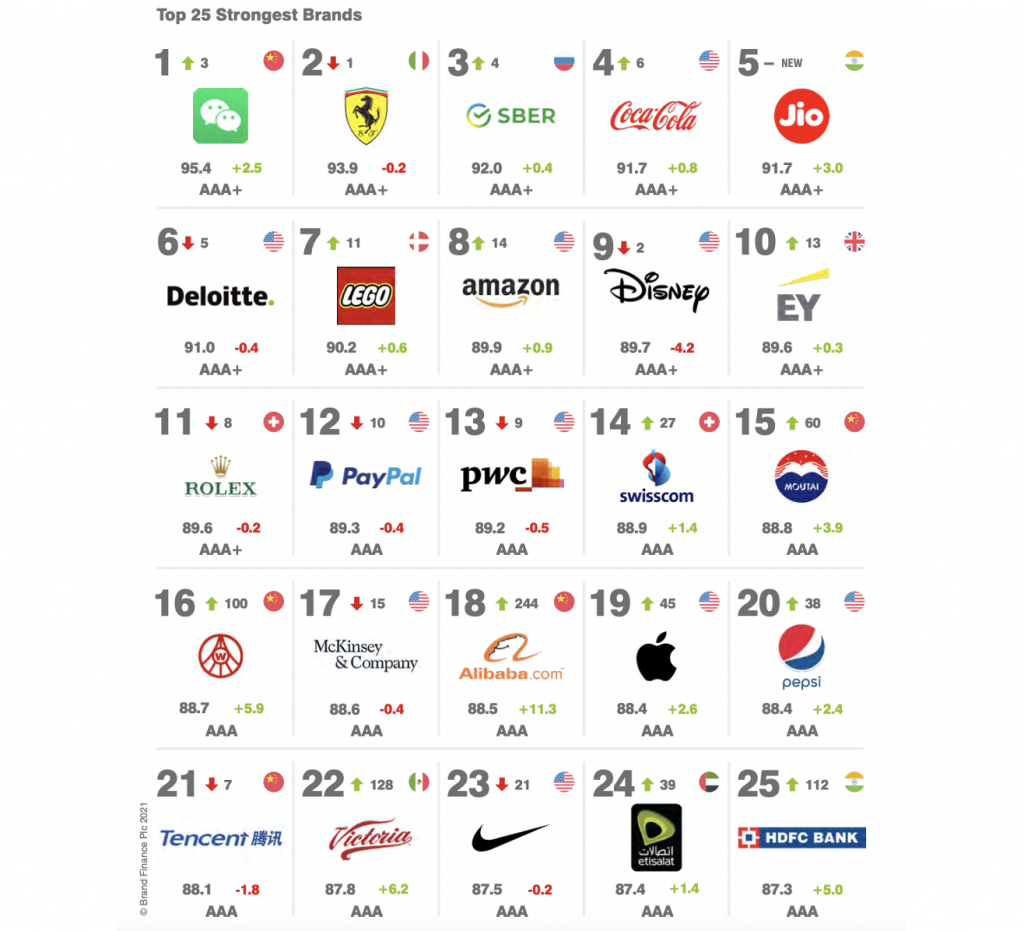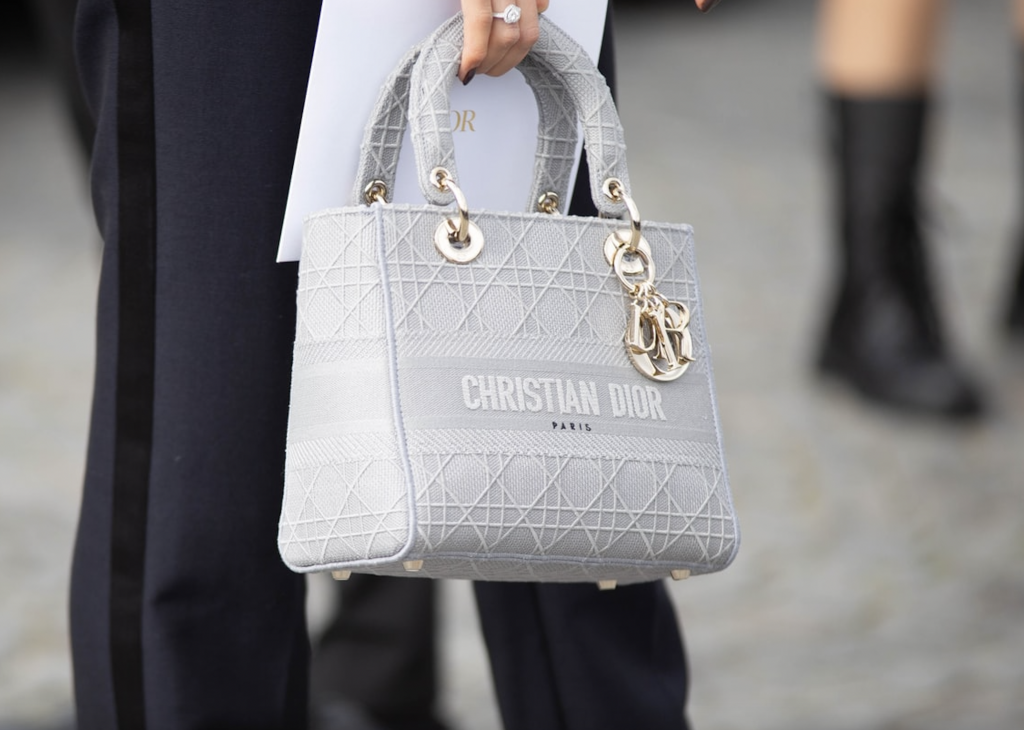Some of the biggest names in luxury do not fare particularly well in a recently-released ranking of the 500 most valuable global brands, with the likes of Gucci, Louis Vuitton, Chanel, Cartier, Hermes, and Tiffany & Co. all ranking lower than last year on Brand Finance’s “Global 500” list, as the COVID-19 pandemic has taken a marked toll across various industries and market segments. The annual review from the London-based consultancy evaluates 5,000 of the world’s largest companies and ranks them by “brand value” – or in other words, “the value of a company’s trademark and associated marketing intellectual property within the branded business,” including intangible assets that are “intended to identify goods, services or entities, [thereby], create distinctive images and associations in the minds of stakeholders, and generate economic benefits.”
While the likes of Louis Vuitton and Chanel, which hold the titles of the two biggest high fashion companies in the world by revenue, among nearly all other high fashion names slid in the ranking for 2021 (some much more than others), other companies predictably fared much better. Apple, for instance, reclaimed the top spot five years after losing it, with a brand value of $263.4 billion, as its “diversification strategy finally pays off.” That meant Amazon was nudged from the number 1 spot (even with an increased brand value of $254.2 billion on a year-over-year basis), followed by Google, Microsoft, Samsung, Walmart, Facebook, IBIC, Verizon, and WeChat respectively rounding out the top 10.
Amazon, Tesla & Others
Speaking specifically of Amazon, Brand Finance asserts that despite relinquishing its top spot to Apple, the Jeff Bezos-founded titan “still managed to record a healthy 15 percent brand value growth to $254.2 billion,” due in large part to the fact that it is “one of the few brands that benefitted considerably from the pandemic and the resulting unprecedented surge in demand as consumers turned online following store closures.” One example of Amazon’s quest to “leverage the circumstances of the pandemic,” per Brand Finance? Its acquisition of 11 passenger planes from struggling North American airlines to expand its air logistics capabilities.
Meanwhile, Amazon’s “Chinese equivalent” Alibaba.com – which ranks at 30 (after landing in the 92 spot in 2020) – has also benefitted from pandemic consumption patterns. The company’s brand value “has been boosted by an eye-watering 108 percent to $39.2 billion, making it the second-fastest growing brand in the ranking behind Tesla,” which took the number 42 spot (from 147 in 2020). Tesla’s brand value surged by 158 percent on a year-over-year basis to $32.0 billion, per Brand Finance reveals. The Elon Musk-led company’s market capitalization grew by $500 billion over the last year, making it “worth as much as the nine largest automobile manufacturers in the world combined.”
Alibaba subsidiaries, Taobao and Tmall, the latter of which is home to its Luxury Pavilion, also “enjoyed parallel successes, with their online business models providing ease of access and convenience for consumers.” Fellow Chinese e-commerce giant JD.com similarly fared well, as did Japanese online retailer Rakuten, and German entity Zalando, in what Brand Finance says is “another testament to the role of technology in driving brand value.”

Brand Finance notes that many traditional brick-and-mortar retailers have successfully leveraged technology to offer online delivery options and develop digital in-store improvements, and as a result, have also fared well during the COVID-19 lockdowns. Walmart’s brand value is up 20 percent on the 2021 ranking to $93.2 billion, putting it in the number 6 spot (up from 8 last year). “With targeted investments in e-commerce and over 400,000 workers hired in the last year to stock shelves and fulfil online orders, Walmart has been quick to adapt to the surge in demand,” Brand Finance states, noting that “similar strategies have been beneficial to Target, which is up 30 percent to $20.7 billion,” nabbing the number 80 spot (up from 114).
As for a retailer that did not do well, Brand Finance points to TJ Maxx, which it says “has endured a difficult year, becoming the fastest-falling retail brand, down 32 percent in brand value to $6.5 billion. The retailer’s struggles are largely due to store closures and a decline in apparel sales during the pandemic.”
Fashion and Luxury Falls
In terms of the most well-known names in fashion and luxury, nearly all lost their footing to some extent, according to the 2021 ranking. Gucci landed in the 117 (down from 98 in 2020), Louis Vuitton is ranked at 123 (from 109), Chanel came in at 137 (down just one spot compared to last year), Cartier 151 (down from 123), Hermès 156 (down just two places from 154), and the newly-acquired Tiffany & Co. is at 362 (down from 345). The only real exceptions to this trend: LVMH-owned Dior – which jumped to the 242 spot for 2021 (it ranked as 298 in 2020), and Rolex, which took the 237 spot (an improvement from 247 last year).
More mass market names, such as Nike and adidas, similarly lost out compared to last year, with Nike taking the number 47 spot compared to 39 last year, and adidas landing in 126 (versus 108 for 2020). Meanwhile, Zara (ranking 128 in 2020) and Uniqlo (ranking 143 in 2020) took the consecutive 139 and 140 positions. And finally, the LVMH-owned beauty retailer Sephora went from the 169 spot in 2020 to 172 in 2021.

WeChat v. Ferrari
On a separate metric – brand strength, which centers on “marketing investment, stakeholder equity, and business performance,” WeChat took the top spot from Ferrari to become world’s strongest brand with top score of 95.4 out of 100 and AAA+ brand strength rating. “Alongside revenue forecasts, brand strength is a crucial driver of brand value,” per Brand Finance, which states that “as one of China’s home-grown tech successes with very strong equity, WeChat enjoyed high scores in reputation and consideration among Chinese consumers, successfully implemented a broad and all-encompassing proposition that offers services from messaging and banking, to taxi services and online shopping – the all-in-one app has become essential to many users’ daily lives.”
Taking the second place spot on the brand strength list, Ferrari – which Brand Finance states “still boasts an extraordinary strength score – reacted pro-actively to the pandemic, initially shutting down production facilities and then reopening with a focus on creating a safe working environment.” This approach “both minimized disruption and reinforced the brand’s reputation as a high-quality and responsible firm,” with the company remaining “a highly desired brand, albeit aspirational rather than accessible for many.”
And speaking of brand strength, Rolex landed on that list again this year, albeit down 8 spots to number 11, but still maintaining the AAA+ “elite standard ranking,” while Nike fell 21 spots to number 23 for the year.
The Value of “Brand Value”
Ultimately, Brand Finance touches on the importance of the brand value and strength metrics, stating that “the most fundamental reason to conduct a valuation analysis is to find out how brands – that is, trademarks and their associated intellectual property – improve the financial performance of a business,” which brands accomplish “by impacting the perceptions that customers, employees and other relevant stakeholders.”
Interestingly, the consultancy states that based on its ranking exercises, it has found that brand-specific elements and assets “consistently make up 20 to 25 percent of the value of listed companies.” Though, Brand Finance cautions that this figure differs by “type of business, industry, segment, stage of life and many other factors.”
Knowing the value of such assets is useful, per Brand Finance, for a whole host of reasons, including calculating damages in connection with instances of trademark infringement. “In order to calculate these damages, some kind of brand valuation exercise is necessary,” the company states. Quantifying brand value is helpful when conducting M&A due diligence, as “a brand evaluation process, identifying how well a brand is known and perceived compared to its competitors can help buyers determine how resilient demand will be and how much growth to expect.” And still yet, if a company is considering a rebrand, it “can be important to quantify the strength and value of the brand being acquired to assess both the positive and negative implications of integrating, merging or rebranding a target brand.”













